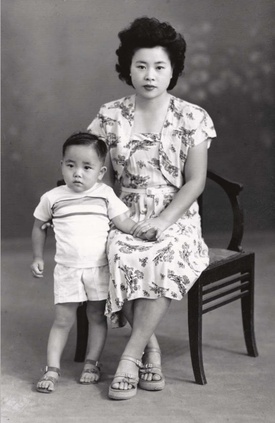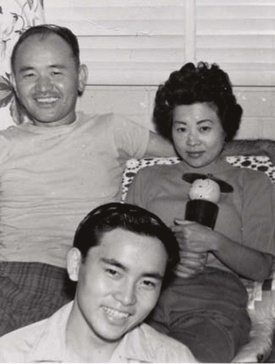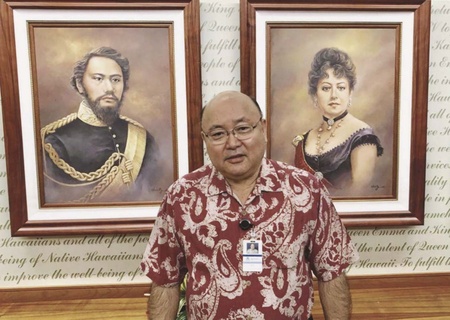The Queen’s Health System – Fulfilling a Royal Legacy
As a child growing up on Maui, Arthur Ushijima remembered his father, James Sueki, telling him that one always took care of family first. Beyond the family, his father added, “You go out and help others.” Ushijima took that advice to heart. Until his retirement in 2020, he devoted four decades of his life to health care and, for the past 30 years, has served the Hawai‘i community at the helm of The Queen’s Health System.
He was first appointed as the chief operating officer at Queen’s Hospital in 1989, then served as president and chief executive officer of The Queen’s Health System from 2005 to 2019. Today, Queen’s is Hawai‘i’s largest health system and one of Hawai‘i’s largest corporations.
Ushijima has fond memories of small kid days on the Valley Isle. His father originally worked for Kahului Railroad and the family lived in “Dream City” that was built by Alexander and Baldwin for their employees. James eventually became county clerk under Mayor Elmer Carvalho. Ushijima’s mother, Kay Keiko, was a Japanese war bride who took care of the family.
College and Military Experiences
An honor roll student at Baldwin High School, Ushijima obtained a degree in biology in 1970 at Cornell College in Iowa. He also met his wife Ruth Morishige at Cornell and they married in 1970. When it was time to pursue a master’s degree at the University of Iowa, he started off in biology and soon veered toward his real passion: business administration. He received an MBA degree in 1973. Biology and business proved to be the perfect nexus for his eventual work in hospital administration.
In 1973, his life took an auspicious turn when he decided to join the Air Force where he learned the basics of fiscal and hospital administration. He ended up serving for seven years, engaged in tours to military bases in Texas, Arizona, and Nebraska, before being assigned to the Air Force surgeon general’s office in Washington D.C.
In his last post, he assisted with the implementation of a project that standardized the financial systems for the Air Force, Army, and Navy. He acquired great exposure to the whole defense infrastructure and the congressional budgeting process as well as the workings of a worldwide multi-hospital, multi-site system.
He noted that throughout his Air Force career, “it was always about knowing who the people are, who gets the job done, who do you have to go to. While the lines of communication and reporting are there, so are the relationships that get the work done.”
Moving to the Private Sector
His interests shifted from military to private hospitals in 1980 when he took a position at St. Mary’s Hospital in Kansas City, Missouri. Ushijima started as an assistant administrator and became the chief executive when that post opened up. Working in this hospital opened his eyes to the differences between the private and military sectors.
He explained, “I now had to recruit physicians at the same time that we had to cut operational costs resulting in layoffs.”
The priority was growing a highly qualified medical staff to attract more patients. He also helped to create a Preferred Provider Organization (PPO) that was one of the first in the country.
He explained, “The PPO allowed our hospital to work with an employer giving favorable discounts for their exclusive volume. We did this with the Atchison, Topeka and Santa Fe Railroad Employee Benefit Association that covered 20,000 retirees and family members.”
Always interested in expanding his professional horizons, in 1985, he accepted a post as chief operating officer at the Akron General Medical Center in Ohio. This was another first for him: managing a community teaching hospital and “learning the breadth and depth of graduate medical education.” He noted, “I learned about negotiating union contracts and managing teaching hospitals.”
He delved into training and educating physicians that meant developing clinical programs along with the residencies for medical students and young physicians. Importantly, he worked closely with the community and began to appreciate the intricacies of organizational and corporate governance.
Joining Queen’s
In 1988, when he received a call regarding a vacancy for the job of COO at Queen’s Medical Center, he considered the option of returning to Hawai‘i. Ushijima said he was struck by the uniqueness of this hospital.
“The monarchs, King Kamehameha IV and Queen Emma, had this commitment to the health and wellbeing of not just Native Hawaiians but to all peoples of Hawai‘i. They established the hospital in 1859. Their royal mission resonated with me.”
He credited Kenny Brown, then board chair, with raising awareness of the monarchy’s mission that has served as the moral compass for this 160-year-old organization. Ushijima accepted the COO post in 1989. He recalled with fondness the advice given to him by a board member, Connie Black, who told him, “Just slow down. You have to take the time and have people understand where you are coming from.”
She became a lifelong friend until her passing. Thus began his three decades of leadership that saw the Queen’s enterprise grow from a small hospital system with an operating budget of $250 million and about 2,500 employees to a regional four hospital system with an operating budget of $1.3 billion and over 7,000 employees. In 2005, Ushijima became the president and chief executive officer for The Queen’s Health Systems. Some of the milestones that he noted:
-
In 1995, creation of one of the early neuro-intensive care units (ICU) in the nation and the first neuro-interventional program in Hawai‘i. Queen’s also established statewide stroke intervention and treatment programs.
-
In 1997, establishment of Hawai‘i’s first adolescent behavioral health treatment program, serving a growing demand and need.
-
In 1998, development of the first positron emission tomography (PET) center in Hawai‘i under a joint venture with Hamamatsu Photonics of Japan. The center was one of the early PET centers in the nation and provided Hawai‘i patients with unique diagnostic modality.
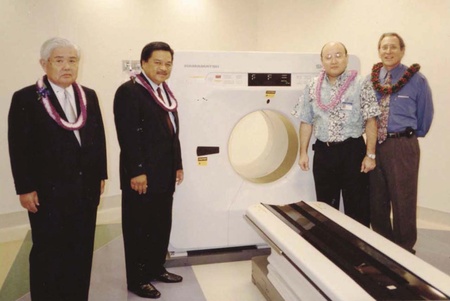
-
In 2011, rated number one in U.S. News Media & World Report’s Best Hospitals rankings for providing numerous services ranging from cancer to geriatrics in the Honolulu metro area.
-
In 2017, verification as a Level I Trauma Center by the American College of Surgeons, which defines the national standard for quality in care of the injured patient. Queen’s is the only Level I Trauma Center in Hawai‘i and the Pacific.
-
Since the inception of the John A. Burns School of Medicine at the University of Hawai‘i in 1965, Queen’s has served as a primary teaching hospital for most of the residency programs.
Landmark Achievements
In sharing these various accomplishments, Ushijima is quick to acknowledge that nothing happens without a team. As he discussed the following major undertakings, he credited different individuals who made change possible.
In 2012, the St. Francis Healthcare System needed to have another hospital assume oversight for the only transplant program in the state. Queen’s took it over as a community service. Ushijima said, “I credited Mark Yamakawa, COO, and Karen Schulz, vice president in surgery, along with transplant surgeons Livingston Wong and Linda Wong for developing a viable transfer plan that was approved by the board. Without this service, over 1,400 transplant patients would have had to relocate to the mainland.”
Around the same time, Queen’s acquired the Hawai‘i Medical Center West. The driving force was the desire to serve the large Native Hawaiian community on the Wai‘anae coast. The overall population was also growing and there was increasing demand for access to better medical services on that end of O‘ahu. According to Ushijima, John Nitao, who was the Queen’s general counsel, coordinated this amazingly complex acquisition. He also commended Susan Murray, formerly with Kaiser Hospital, for building up Queen’s West.
Queen’s interests also extended to the neighbor islands. In 2014, North Hawai‘i Community Hospital became part of the Queen’s system. There were challenges including the recruitment of private physicians and contract physicians in areas like orthopedics and oncology. Equally difficult was the need to manage costs that meant analyzing the infrastructure of the existing system and re-assessing and re-describing jobs.
He asked Cindy Kamikawa, chief nursing officer at Queen’s, to be in charge. He attributed the program’s success to Kamikawa’s skills in building a strong team and listening to the community. This meant taking the time to observe how people worked and to nurture and support those staffers who were quietly getting tasks done. It required building trust.
Ushijima added, “The facility provided primary care and brought critical specialists to the Waimea area. These were services that they may not have otherwise. Queen’s North Hawai‘i Community Hospital has saved a lot of patients’ lives by being there.”
The Royal Legacy Honored
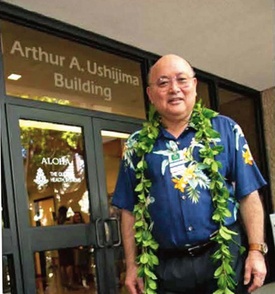
Throughout his tenure, Ushijima and his staff have focused on the following strategic priorities: providing quality patient care, being a provider of choice, being an employer of choice and being responsive to community needs. The Queen’s enterprise has maintained a sound fiscal base to support the needs of patients and the community.
In addition to advancing health care in the state, Queen’s contributes nearly $200 million in annual community benefits. Ushijima originally delegated the fundraising program to Sharlene Tsuda, vice president for media affairs. She leveraged her impressive community network to “friend raise” for funding. Not many realize that the system currently offers 62% of the hospital care for the homeless in the state at an annual cost of nearly $40 million.
Reflecting on his years at Queen’s, Ushijima maintains that the greatest asset for the organization has been the dedication and resourcefulness of long-term staff members. He considers himself blessed to have worked with great people who supported the organization’s mission to responsibly grow the system.
When folks have asked him to describe his legacy, his response has been “I don’t have a personal legacy. I worked for one that was established by the monarchs.” Ushijima envisions himself as a “caretaker” who helped to fulfill the royal legacy.
He recalls his father emphasizing the values of humility and integrity. “You are never as good as you think you may be. It’s always about other people and being conscious of them, being aware of them and their needs.” Ushijima has lived these values to the fullest.
Editor's Note: This series, “Honoring the Legacy,” is a partnership between The Hawai‘i Herald and the Japanese Cultural Center of Hawai‘i. It celebrates the achievements of Japanese American men and women who live the values of earlier generations and continue their proud legacy. The complete interview with Arthur Ushijima is available at the JCCH Tokioka Heritage Resource Center. It can also be read online.
*This awas originally published in the Hawai'i Herald on June 2, 2023.
© 2023 Melvin Inamasu and Violet Harada Courtesy: Japanese Cultural Center of Hawai‘i



